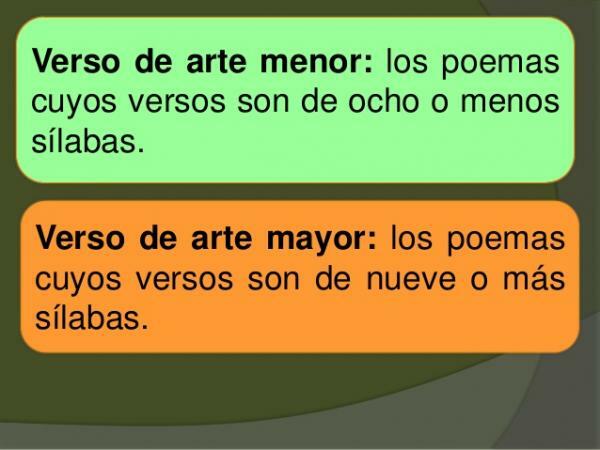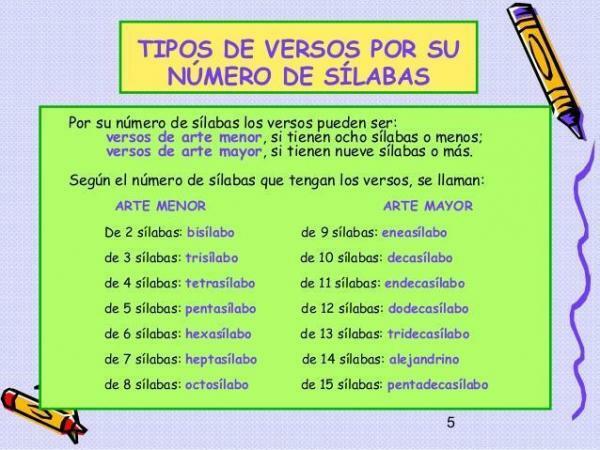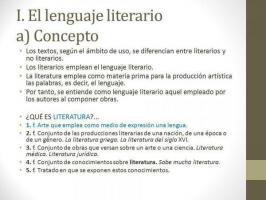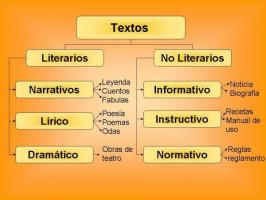What is major and minor art in poetry

Image: Slideshare
According to the type of syllables containing each of the verses that make up the stanzas of a poem, these can be classified into two large groups: poems with verses of major art and poems with verses of minor art. Throughout this lesson from a TEACHER we will explain what is major and minor art in poetry because, although it may seem very difficult at first, you only need to know how to count the syllables of the poem to determine if you are facing a poem written in verses of major art or, on the contrary, you are facing a poem written in verses of minor art. Keep reading!
Index
- Minor art verses
- Major Art Verse
- Division of the verses of major art in Spanish
Verses of minor art.
Within Spanish poetry, we understand by verse of minor art that which consists of eight syllables or less than eight. The verses of minor art are measured, according to the parameters of the Hispanic metric, using the lowercase letter: "abc".
In the Castilian metric, within the verses of minor art we find
different types, which are the following:- Disyllables: are those verses of minor art composed of two syllables. It is the least frequent of all of them, and when it appears, it is usually combined with others such as the trisyllable.
- Trisyllables: minor art verses of three syllables, which is rarely used, like the bisyllable.
- Tetrasyllables: they are the verses made up of four syllables, which are already more frequent than the previous two. An example: In the dams / I divide / I caught it / equally. / I only want / for wealth / the beauty / non-rival.
- Pentasyllables: verses composed of five syllables.
- Hexasyllables: verses formed by six syllables
- Heptasyllables: together with tetrasyllables and octosyllables they are the most recurrent
- Octosyllables: are the verses formed by eight syllables. This is the characteristic verse of the Spanish ballads and one of the most used and prolific throughout the history of poetry written in Spanish.
In this other lesson we will discover the different rhyme classes in a poem.
Major art verse.
In front of the verses of minor art, we find the verses of major, which are those that are made up of more than eight syllables. To differentiate them from the verses of higher art, which are represented by lowercase letters, the verses of major art, when counting the number of verses and the rhyme of the poem, represent with capital letters: ABC.
In addition, compared to the minor art verse, more used in popular lyric and worldly themes, the major art verse is more solemn and elevated, so it is more appropriate and is used more often in cultured poetry, which deals with existential issues and that deeply touch the human being.
Of the different types of verses of major art that exist, undoubtedly the most used by poets throughout the centuries is the hendecasyllable; that is, that verse of major art composed of 11 syllables, like the following verse taken from a sonnet by Garcilaso de la Vega:
By rough roads I have come / apart from the fear that I do not move; / and if to move to take a step I try, / and there by the hair I am tornado.

Image: Prezi
Division of the verses of major art in Castilian.
The major art verses are divided into different subcategories. In addition to the hendecasyllable, we have the hendecasyllable (verse of nine syllables), the decasyllable (verse of ten syllables), the dodecasílabo (verse of twelve syllables), the tridecasílabo (verse of thirteen syllables) and the tetradecasílabo (verse of fourteen syllables).
Among the above, the one that stands out the most is the Alexandrian verse, which is a type of tetradecasyllable verse; that is, a verse composed of fourteen syllables but which in turn is divided into two hemistichs of seven syllables each; that is, two heptasyllables that are separated from each other through a pause called caesura.
For example, one of the authors who best used the Alexandrian verse was Ruben Dario. Next, we show you one of the best known poems of him, written in Alexandrians:
The princess is sad... What will the princess have? / Her sighs escape her mouth from Strawberry,/ her that she has lost her laughter, that she has lost her color. / The princess is pale in her golden chair, / the keyboard of her sonic key is mute; / and in a glass, forgotten, a flower faints.
If you want to read more articles similar to What is major and minor art in poetry, we recommend that you enter our category of Literary concepts.



